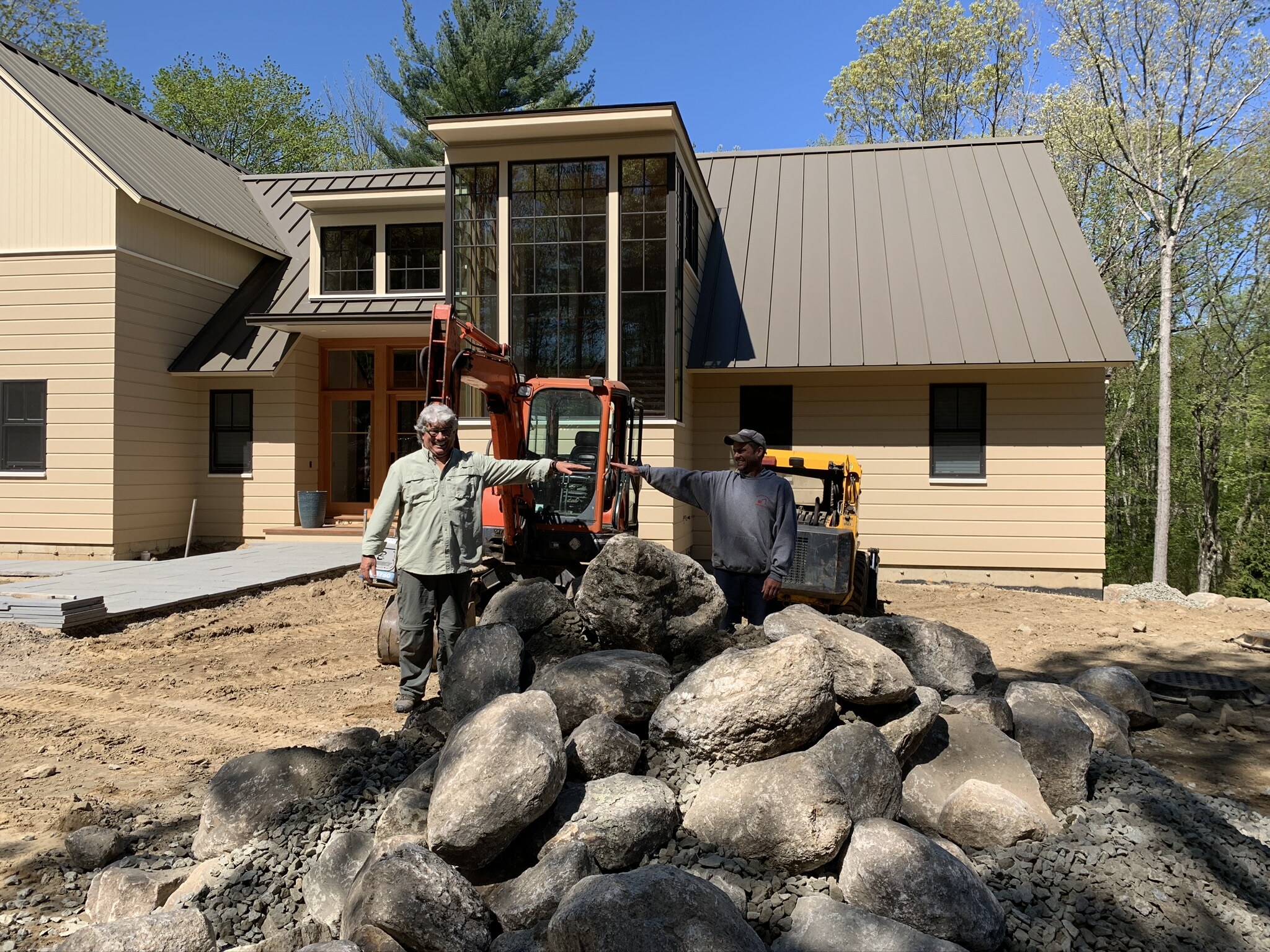Regenerative landscape design and implementation is a core concept for The Garden Continuum. We aim to improve the health of the soil and local ecosystem through the design and implementation of landscapes that delight and inspire. We strive to offer benefits like increased biodiversity and water filtration along with improving pollinator habitat. However, building these landscapes can be complex, as it requires careful consideration of factors like native plant selection, soil building practices, and minimal disruption to the existing environment.
Challenges of Collaborative Construction
Access and scheduling - Minimizing impact on the land during construction requires meticulous planning for access, scheduling, and resource management. Coordinating with all contractors beforehand to establish designated vehicle access routes, parking zones, and material staging areas helps limit unnecessary disturbances to the natural environment. This can sometimes feel inconvenient for contractors and clients but is essential for protecting the land from undo compaction and damage.
Project Management - Furthermore, a central point of contact, such as a project manager, is crucial for smooth workflow. This designated individual ensures clear communication and contractor collaboration, fostering seamless transitions and preventing scheduling conflicts between trade professionals. By working together and planning these aspects thoroughly, construction can proceed efficiently while respecting the integrity of the surrounding landscape. Your project manager should have intimate knowledge of the design intent, the project nuances, the client’s goals, and the contractor's needs. Their work requires participation from the start to the end of the project development.
Respect for the industry and contractor alignment - When it comes to regenerative landscape projects, the goal is to work in alignment with natural systems while understanding the specifics of the project site. This requires respecting an often misunderstood industry while aligning with the lead contractor and their unique subcontractors. Collaboration is critical, especially when working with those unfamiliar with these practices. Starting with the clients, we, as designers, project managers, and lead contractors, want to ensure they are briefed on all participants in the construction process. This includes sharing schedules, names and scope of work, and the details of the chain of command. A surefire way to undermine a project is to put too many cooks in the kitchen, to coin a common restaurant adage. Clearly outline the strategy for decision-making, both on-site and off. Barring an emergent situation, avoid pushing through changes without the project manager’s and/or designer’s approval.
Bridging the gap between traditional and regenerative practices - Aligning the often fast-paced conventional construction methods with the more nuanced approach of regenerative landscaping can be challenging. However, client and contractor education can significantly reduce those challenges. By fostering a collaborative spirit, explaining regenerative principles, and clearly articulating how decisions are made, project managers can empower contractors to embrace new techniques while giving the clients confidence in their team. This approach ensures successful project outcomes and paves the way for a future where respect for the industry and regenerative practices go hand-in-hand.

Challenges Specific to Regenerative Practices
Timing and change orders - Due to the dynamic nature of all projects, surprises can arise. Unexpected discoveries during construction, like hidden underground features (like ledge or stumps) or fluctuations in native plant and material availability, might necessitate on-the-fly adjustments. Open communication with clients throughout the process is crucial. By keeping them informed of potential changes and the rationale behind them, project managers can manage expectations and minimize the need for disruptive change orders. Respecting the client's decision-making process is paramount. Rushing through adjustments to meet unrealistic deadlines can compromise the project's integrity. Instead, encouraging an environment where all parties have a voice ensures the project unfolds smoothly, with the client feeling involved and the regenerative vision intact.
Unforeseen circumstances and construction creep - The Garden Continuum acknowledges that surprises are inevitable during construction, and even minor additions, often called "construction creep," can snowball and impact budgets and timelines. To combat this, we take a proactive approach that strives to minimize construction creep through meticulous pre-planning and clear client communication at the project's onset. This can mean it takes longer to complete a design or finalize a project contract, but it also limits change orders and unforeseen additions to the budget. This proactive approach ensures that all parties know potential challenges before construction and are prepared to address them efficiently, allowing the project to stay on track and within budget.
Solutions and The Garden Continuum's Approach
At The Garden Continuum, we tackle the inherent complexities of regenerative landscapes head-on with detailed site assessments to uncover hidden surprises before construction begins. Upfront communication with clients about potential changes due to factors like site discoveries or plant availability helps manage expectations and minimizes the need for disruptive change orders. To bridge the knowledge gap, they hold collaborative planning sessions with contractors, fostering a spirit of education and ensuring everyone is aligned with the project's regenerative goals. Finally, they develop contingency plans for unforeseen circumstances, allowing flexible adjustments without compromising the project's vision or budget. Through this comprehensive approach, we strive to create beautiful and restorative landscapes while respecting the land and navigating the inevitable challenges that arise.
Woodland & Ledge - there is a challenge in developing a landscape that requires significant change to the pre-existing landscape environment. In this project, we faced a newly constructed home set into a rustic young woodland of predominantly ledge, sandy soil, and slope into a wetland system. Nothing about the soil in this system would support lawns, gardens, or even meadows. So, while the client wanted a native, regenerative landscape, soil work would be required to support this desire. The plantings are simple and primarily native, so the bulk of the work was developing healthy soil to support new plantings. We used organic matter, biochar, nutrients, and bio-inoculants to jumpstart the biology necessary to build the beginnings of an environment that would host the desired native plants. To fill this landscape, we planted a diverse pallet of balled-and -burlaped, container-grown, and plug-sized plants. We added drip irrigation to offer the needed hydration. This project was planted in Massachusetts during a hot, dry July and was successful from day one. The focus on soil development and proper hydration gave the plants what they needed to survive right out of the gate.
Backyard Renovation - the beauty of working with old established landscapes is that there is often great soil. Sadly, however, construction practices can create so much compaction and upheaval that the soil's delicious biological history is crushed beyond repair. In this project, we worked closely with the site contractor, mason, and pool technicians to ensure that the access points to this project were limited and focused. Then, for the areas we knew would be deeply damaged, we implemented a soil remediation program to help build a new biological foundation that could heal the soil over time. That and the plant selections and follow-up care proved highly successful. There is horticultural diversity and lush vegetation that both support the pollinator community and delight the clients.
The Garden Continuum recognizes that while design is the basis for a beautiful landscape, transparent collaboration and systematic implementation practices are the cornerstones of successful regenerative landscapes. By openly communicating with clients about how their project will be constructed, how the process will unfold, and what potential challenges are ahead, we set reasonable expectations for the timeline and the budget. By working respectfully alongside all contractors, we can navigate the project development effectively while ensuring we can deal with any unforeseen conditions professionally. This commitment to collaboration fosters a spirit of education and empowers everyone involved to achieve the best possible outcome within a reasonable timeframe. If you live in our service area of Massachusetts and are interested in creating a Life-Scape on your property, The Garden Continuum offers complimentary consultations to discuss your goals and the possibilities. If you want more project design and development details, get your copy of STOP Landscaping, START Life-Scaping today. You can also download their guide on regenerative gardening best practices to learn more about this innovative approach to landscape design and how it helps reduce the harmful effects of climate change. Let's work together to build a healthier future, one regenerative landscape at a time.
Learn more about Fine Gardening by downloading the eBook titled "The Fine Gardeners Guide to a Beautiful and Luxurious Landscape" today.





-1.png?width=1200&length=1200&name=Untitled%20design%20(3)-1.png)
-1.png?width=1200&length=1200&name=Untitled%20design%20(2)-1.png)



Leave a comment